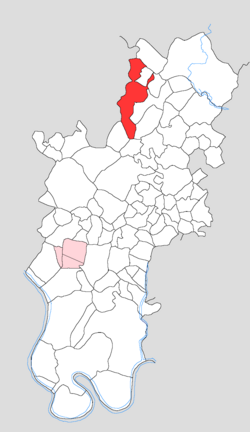Shekhupur Rajmal
Shekhupur Rajmal | |
|---|---|
Village | |
 Map showing Shekhupur Rajmal in Tundla block | |
| Coordinates: 27°20′41″N 78°17′08″E / 27.3445844°N 78.2856013°E | |
| Country | India |
| State | Uttar Pradesh |
| District | Firozabad |
| Tehsil | Tundla |
| Area | |
• Total | 9.502 km2 (3.669 sq mi) |
| Population (2011)[1] | |
• Total | 6,395 |
| • Density | 670/km2 (1,700/sq mi) |
| Time zone | UTC+5:30 (IST) |
| PIN | 207302 |
Shekhupur Rajmal (Śekhūpur Rājmal) is a village in Tundla block of Firozabad district, Uttar Pradesh. It was formerly part of Etah district. As of 2011, it has a population of 6,395, in 1,067 households.
Demographics
As of 2011, Shekhupur Rajmal had a population of 6,395, in 1,067 households.[1]: 85 This population was 54.1% male (3,457) and 45.9% female (2,938). The 0-6 age group numbered 1,036 (542 male and 494 female), making up 16.2% of the total population. 1,257 residents were members of Scheduled Castes, or 19.7% of the total.[2]: 92–3
The 1981 census recorded Shekhupur Rajmal as having a population of 3,793 people (2,065 male and 1,728 female), in 680 households and 664 physical houses. It was then counted as part of Jalesar block and tehsil in Etah district.[3]: 128–9
The 1961 census recorded Shekhupur Rajmal (as "Sheikhupur Rajmal") as comprising 8 hamlets, with a total population of 2,657 people (1,482 male and 1,175 female), in 486 households and 404 physical houses. The area of the village was given as 2,379 acres and it had a post office and medical practitioner at that point. It was then counted as part of Jalesar block and tehsil in Etah district.[4]: Lii
Infrastructure
As of 2011, Shekhupur Rajmal had 2 primary schools; it did not have any healthcare facilities. Drinking water was provided by hand pump; there were no public toilets. The village had a sub post office but no public library; there was at least some access to electricity for all purposes. Streets were made of both kachcha and pakka materials.[1]: 85–90
References
- ^ a b c d "Census of India 2011: Uttar Pradesh District Census Handbook - Firozabad, Part A (Village and Town Directory)" (PDF). Census of India. Retrieved 19 June 2023.
- ^ "Census of India 2011: Uttar Pradesh District Census Handbook - Firozabad, Part B (Village and Town Wise Primary Census Abstract)" (PDF). Census of India. Retrieved 19 June 2023.
- ^ Census 1981 Uttar Pradesh: District Census Handbook Series 22 Part XIII-B: District Etah (PDF). 1983. Retrieved 21 November 2023.
- ^ Census 1961: District Census Handbook, Uttar Pradesh (23 - Etah District) (PDF). Lucknow. 1965. Retrieved 21 November 2023.
{{cite book}}: CS1 maint: location missing publisher (link)

